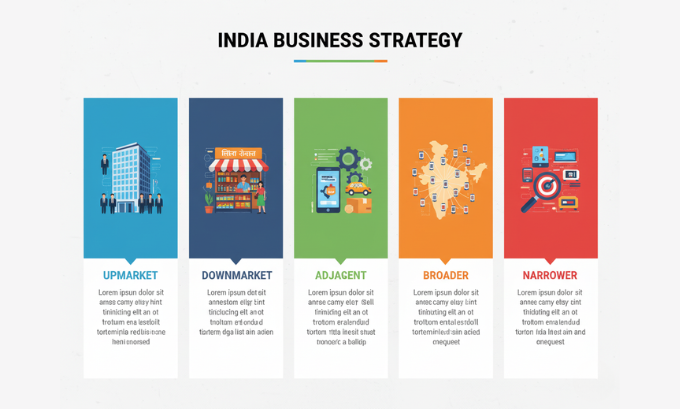Scaling a business in India is an unparalleled opportunity. It’s a continent-sized market with incredible diversity, a rapidly growing digital economy, and boundless ambition. But scaling here is not just about growing; it’s about navigating a complex landscape of varied cultures, languages, and consumer behaviors. To succeed, you must increase revenue faster than costs, adapting proven global strategies to the vibrant and unique Indian context.
This guide offers a practical blueprint on how to scale a business successfully in India. We will dive into actionable frameworks, explore strategies tailored for the Indian market, and draw lessons from both global giants and local champions. You will learn how to build a resilient, profitable, and scalable operation in one of the world’s most dynamic economies.
Table of Contents
The Indian Scaling Mindset: Speed, Frugality, and Agility
To understand how to scale a business successfully in India, you must first grasp the local business philosophy. India is a market that rewards speed, agility, and “jugaad”—a flexible, frugal approach to problem-solving. It’s about doing more with less and moving quickly to capture opportunities. Scaling here is not just about linear growth; it’s about finding exponential leverage in a high-volume, often price-sensitive environment.

The core principle of scaling remains the same: you want to serve a thousand customers with the operational effort it takes to serve a hundred. In India, this is achieved through a combination of technology, hyperlocal strategies, and a deep understanding of the consumer psyche. It’s less about perfection and more about rapid iteration and market responsiveness.
Setting Ambitious and Relevant SMART Goals
To navigate this fast-paced market, your goals must be both ambitious and grounded. The SMART Goals framework is essential for providing this direction, but it needs to be adapted for the Indian context. Your objectives should be:
- Specific: Instead of “gain market share,” aim for “Onboard 50,000 users from Tier-2 cities like Pune and Jaipur in the next quarter.”
- Measurable: Track key metrics like cost per acquisition (CPA), monthly active users (MAUs), and customer lifetime value (LTV), paying close attention to regional differences.
- Attainable: India’s market is vast. Set bold goals, but ensure they are realistic given the operational complexities of a multi-state rollout.
- Relevant: Your goals must align with the long-term vision of building a brand that resonates with the Indian consumer. This means focusing on value and trust.
- Time-bound: Deadlines are crucial in a competitive market. Set clear timelines to maintain momentum and a sense of urgency.

Using SMART Goals with an Indian filter helps you create a concrete plan that accounts for both the scale of the opportunity and the realities on the ground.
A Global Framework for Hyperlocal Growth
While India is unique, universal business principles still provide a powerful strategic foundation. The Scaling Framework from Alex Hormozi, the founder of Acquisition.com, offers a clear model for market expansion. By adapting his five strategic paths, you can make deliberate choices to expand your Total Addressable Market (TAM) in India.
If you want to know more about scale a business successfully you can read this articles ponta.in or gogonihon.jp.net
My Experience: Pivoting for the Indian Market
I was once involved with a SaaS company entering the Indian market. Our strategy was to replicate our US model, targeting mid-sized enterprises. We had a superior product, but we were gaining no traction. The sales cycles were long, and decision-makers were hard to reach. We were burning cash with little to show for it.
We had to pivot. Drawing inspiration from Hormozi’s framework, we analyzed the market and realized the real opportunity was not in the mid-market, but with the millions of small businesses and individual creators going digital for the first time. We decided to go downmarket.
This meant re-engineering our product to be simpler, mobile-first, and much more affordable. We introduced a freemium model and invested heavily in digital marketing and content in regional languages. It was a massive undertaking, but it transformed our business. We tapped into a huge, underserved market segment and began to scale at a pace we never thought possible.
Just as a scaling business needs localization, platforms like TokyoMart.store exemplify how tailoring offerings for specific markets drives customer loyalty and sustainable growth.
Why This Framework Works in India:
- Forces Strategic Clarity: In a market as vast and distracting as India, focus is everything. This model forces you to choose a clear path.
- Highlights the Importance of TAM: It makes you consciously think about which segment of India’s enormous market you are actually targeting.
- Universally Applicable Logic: The core concepts have been applied by successful companies everywhere, from global players like Salesforce to Indian unicorns.
Potential Pitfalls in the Indian Context:
- Underestimating Diversity: A strategy that works in Mumbai may fail in Chennai. “Going broader” without a hyperlocal approach is a recipe for disaster.
- Price vs. Value Perception: Going downmarket can be powerful, but it’s easy to get caught in a price war. The key is to offer incredible value at an accessible price point.
- Execution Complexity: Scaling across multiple states in India is like scaling across multiple countries, with different languages, regulations, and consumer habits.
The 5 Strategic Paths, Reimagined for India
Let’s explore how the five strategies from the Scaling Framework can be tailored to scale a business successfully in India.

1. Go Upmarket (Targeting India Inc.)
This strategy involves selling to India’s largest corporations and conglomerates. These are high-value contracts that bring stability and prestige. Success here requires a strong network, a sophisticated sales team, and the patience to navigate complex procurement processes.
- Example: Microsoft and Salesforce have successfully gone upmarket in India by setting up local headquarters, building large enterprise sales teams, and forging deep partnerships with Indian IT giants like TCS and Infosys.
2. Go Downmarket (Tapping into the Masses)
This is one of the most powerful plays in India. It means creating a product or service for the millions of consumers and small businesses in Tier-2, Tier-3, and rural areas. This strategy relies on high volume, low price points, and a mobile-first approach.
- Strategy: Success here is about scale and efficiency. You need a product that is easy to use, a seamless digital payment integration, and a viral or low-cost customer acquisition model. Think of companies like Meesho or PhonePe.
3. Go to an Adjacent Market (Expanding Your Niche)
This involves leveraging your success in one vertical to expand into a related one. For example, a fintech company that provides payment solutions for restaurants could adapt its offering for kirana stores (small neighborhood shops).
- In Practice: This is a common growth strategy for Indian startups. Once you build trust and a distribution network in one segment, you can use that as a launchpad to offer new services to the same audience or enter a similar vertical.
4. Go Broader (A Pan-India Play)
This means generalizing your offering to target a wide swath of the Indian market simultaneously. This is an extremely difficult and capital-intensive strategy. It requires a massive marketing budget, complex logistics, and a product with universal appeal.
- Risk: India is not a monolith. A broad, one-size-fits-all message often resonates with no one. This strategy is typically only viable for established giants or companies with massive venture backing.
5. Go Narrower (The Niche Dominance Strategy)
This approach involves focusing on a specific, well-defined niche and dominating it. For example, instead of targeting all Indian e-commerce, you might focus exclusively on direct-to-consumer (D2C) brands in the beauty and wellness space.
- Benefit: This allows you to build a strong brand and deep expertise. In a noisy market, being a specialist is a powerful differentiator. Once you own a niche, you can use that credibility to expand into adjacent markets or go upmarket.
Comparing Scaling Strategies for India
| Scaling Strategy | Primary Advantage in India | Key Challenge in India | Best For |
|---|---|---|---|
| Go Upmarket | High-value, stable contracts; brand prestige. | Long sales cycles; intense competition from global and local players. | B2B companies with a strong value proposition and deep pockets. |
| Go Downmarket | Massive volume and market size. | Low margins; requires extreme operational efficiency and cultural nuance. | B2C or B2B2C companies with a simple, mobile-first product. |
| Go Adjacent | Leverages existing brand trust and distribution. | Requires deep understanding of the new vertical’s specific needs. | Startups that have already achieved product-market fit in one niche. |
| Go Broader | Huge theoretical TAM. | Operational nightmare; high cash burn; risk of a diluted message. | Highly capitalized companies or established market leaders. |
| Go Narrower | Builds a strong, defensible brand; capital efficient. | Smaller initial market size. | Most new entrants and early-stage startups. |
Building a Scalable Engine for India
Your strategy will only succeed if you have the operational engine to execute it. In India, this means building for scale from day one, with a focus on technology that can handle massive volume and a team that is both skilled and culturally fluent.
Technology: The Backbone of Indian Scale
Technology is not just an enabler in India; it is the fundamental driver of scale. With one of the world’s largest internet user bases, a digital-first approach is non-negotiable.
- Mobile-First is a Must: India skipped the desktop era and went straight to mobile. Your product, website, and marketing must be optimized for mobile devices.
- Digital Payments Integration: With the success of UPI (Unified Payments Interface), seamless digital payments are an expectation. Integrating with popular payment gateways is critical.
- Cloud Infrastructure: You need a robust and scalable cloud infrastructure that can handle huge spikes in traffic, especially during festivals or marketing campaigns.
The Hybrid Team: Global Vision, Local Execution
You cannot scale in India without a strong local team. However, building a team in a market this large and diverse is a challenge. A hybrid model, combining core local leadership with flexible talent, is often the most effective approach.
Platforms like Upwork can be invaluable here. They give you access to a vast pool of Indian freelance professionals. You can hire a regional marketing manager for a product launch in South India, a content creator who understands the nuances of Hindi heartland consumers, or a developer to build a mobile app. This model allows you to tap into specialized skills as needed and build a presence across the country without the massive fixed costs of a large, centralized team.

Global leaders have long understood the power of flexible talent. Microsoft, for instance, has used this model to scale functions like content creation. This same principle allows a company entering India to build an agile, expert team on the ground. Similarly, the influence of digital marketing leaders like Neil Patel and Gary Vaynerchuk (GaryVee) shows the power of leveraging digital platforms to build authority and reach a vast audience, a tactic that is essential for scaling in India.
FAQs: Your Questions on Scaling in India
1. What is the single most important factor for scaling in India?
Understanding the customer. India’s diversity means there is no “average” consumer. Deeply understanding the needs, aspirations, and constraints of your specific target segment is the most important factor for success.
2. How do I handle the linguistic and cultural diversity?
Start with a focused region and language. Don’t try to be everywhere at once. Hire local talent from the regions you are targeting. Use a platform like Upwork to find translators and marketers with native fluency.
3. Is it better to build from scratch or acquire a local company?
It depends on your capital and risk appetite. Building from scratch gives you more control but is slower. Acquiring a local company can give you instant market access and a team, but integration can be a major challenge.
4. How important is pricing in the Indian market?
Pricing is critical. India is a value-conscious market, not just a price-conscious one. Customers are willing to pay for quality and convenience, but your pricing must be competitive and justified by the value you offer.
5. What legal and regulatory hurdles should I be aware of?
India’s regulatory landscape can be complex, covering everything from data privacy (Digital Personal Data Protection Act) to taxation (GST). It is essential to have expert legal and financial counsel from the very beginning.
Effective scaling also depends on building strong online presence—services from LinkLuminous.com help businesses amplify their digital visibility in new markets
Conclusion: Seizing the India Opportunity
Learning how to scale a business successfully in India is a journey of adaptation, persistence, and strategic focus. It’s about applying universal frameworks like the one from Acquisition.com with a deep respect for local realities. It means building a business that is as agile and resourceful as the market itself.
Whether you choose to go downmarket to serve the next billion users or go upmarket to partner with India’s corporate giants, your success will hinge on your ability to build a scalable operational engine. By embracing technology, adopting a flexible talent strategy, and putting the Indian consumer at the heart of everything you do, you can build a formidable and lasting business in this incredible country.
About the Author
This article was crafted by a team of international business strategists and market-entry experts with extensive on-the-ground experience in India. Our insights are drawn from launching and scaling ventures across various sectors in the Indian market, combined with deep research into the country’s economic and cultural landscape.
References & Further Reading
- Hormozi, Alex. Conceptual application of the Scaling Framework.
- Invest India. The National Investment Promotion and Facilitation Agency of India.
- NASSCOM. Reports on India’s IT and Tech Startup Ecosystem.
- Upwork Inc. Resources on Building and Managing Hybrid Teams.


